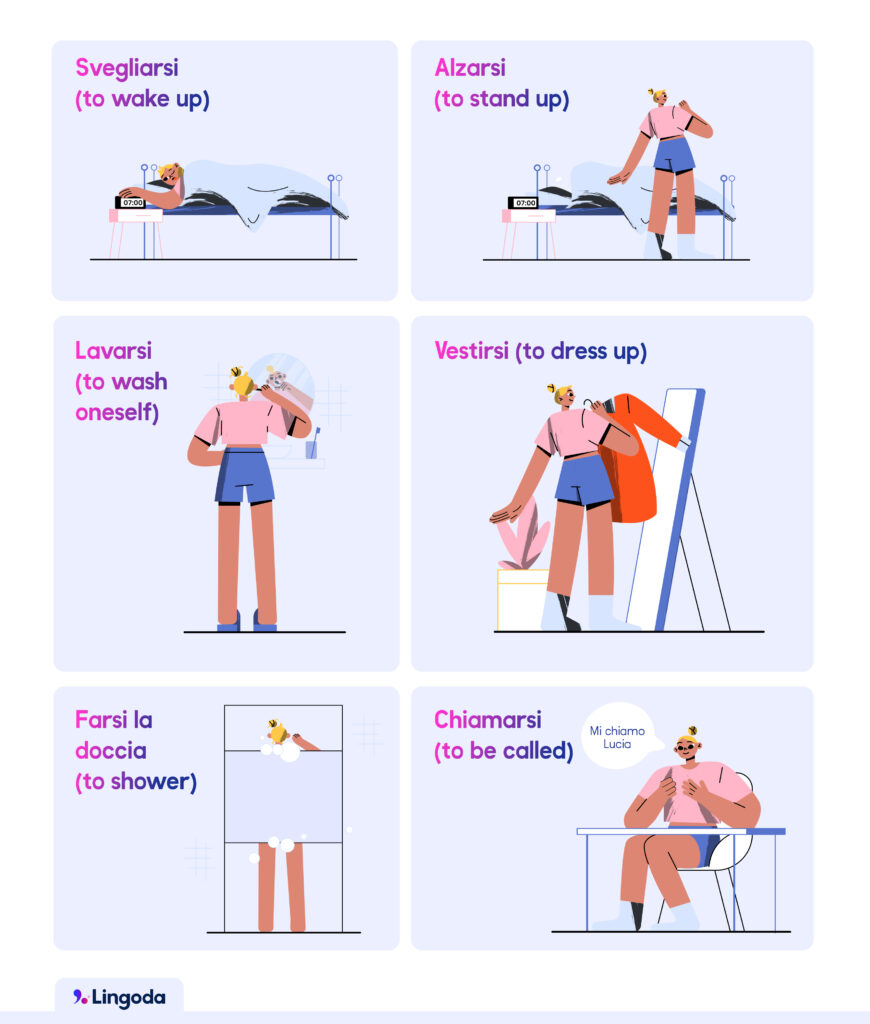Updated on January 14, 2025

Italian reflexive verbs made easy

If you’ve ever tried describing your morning routine in Italian, you’ve most likely resorted to reflexive verbs. These verbs follow a specific structure that consists of a reflexive pronoun preceding the verb itself, with the latter conjugated in the appropriate tense. In their infinite form, reflexive verbs in Italian end with the suffix -si, rather than with one of the three regular verb endings (-are, -ere or -ire).
So, why do we use reflexive verbs in Italian? In short, these verbs help to communicate actions done to oneself. You’ll find they are useful when talking about everyday actions like waking up (svegliarsi), getting dressed (vestirsi) or even having fun (divertirsi). Notice that not all of these actions are “done to oneself” in the same sense we understand in English, so don’t get tied up trying to literally translate every reflexive verb you come across.
The following guide will walk you through the ins and outs of Italian reflexive verbs, from their structure to their quirks in different tenses. Pronti? (Are you ready?)



Reflexive verbs in Italian describe an action the subject performs on themselves, thus rendering the subject and object of the verb the same. You can recognize these verbs by the reflexive pronouns (mi, ti, si, ci, vi, si) that introduce them.,
The key difference between reflexive and regular verbs lies in the role the subject assumes in the sentence. While non-reflexive verbs typically describe actions performed on someone or something else, reflexive verbs indicate actions performed on oneself. The presence of the reflexive pronoun is a giveaway that the verb itself is reflexive.
| Regular verb | English | Reflexive verb | English |
| lavo i piatti | I wash the dishes | mi lavo le mani | I wash my hands |
| chiama un amico | she calls a friend | si chiama Marco | he is called Marco |
| sveglio mio fratello alle otto | I wake my brother up at eight | mi sveglio alle otto | I wake up at eight |

Reflexive pronouns (mi, ti, si, ci, vi, si) are essential components of Italian reflexive verbs because they indicate that the action of the verb reflects back onto the subject. These pronouns must agree with the subject of the sentence in person and number. Let’s take the verb alzarsi (to get up) as an example:
| Subject pronoun | Reflexive pronoun | Example | English |
| io | mi | mi alzo presto | I get up early |
| tu | ti | ti alzi presto | you get up early |
| lui/lei | si | si alza presto | he/she gets up early |
| noi | ci | ci alziamo presto | we get up early |
| voi | vi | vi alzate presto | you get up early |
| loro | si | si alzano presto | they get up early |
Reflexive pronouns usually precede the verb when it is conjugated. However, when used with modal verbs like potere (to be able to), volere (to want) or dovere (to have to), the reflexive pronoun can either:
Both ways are acceptable and interchangeable. This flexibility allows for different sentence structures while maintaining the same meaning.
Reflexive pronouns are used consistently across all tenses, with their placement and usage adapting to the structure of the verb.
In the present tense, they appear before the conjugated verb:
In the passato prossimo, they appear as follows: subject + reflexive pronoun + auxiliary essere + past participle. Note that the past participle must agree in gender and number with the subject (lavato, lavata, lavati, lavate, etc.).
We’ll dive a bit deeper into this tense later on.
In the future tense, the reflexive pronoun can either be placed before the verb or attached to the infinitive:
In negative sentences, reflexive pronouns maintain their usual position, but the negation non is placed before the pronoun and verb:
In interrogative sentences, the position of reflexive pronouns remains as if you conjugated the verb in an affirmative sentence. Intonation and the interrogation mark determine whether the sentence is a question:
When paired with modal verbs in a negative or question format, the reflexive pronoun can either attach to the infinitive or precede the conjugated verb:
Conjugating reflexive verbs in Italian involves three simple steps:
| Subject Pronoun | alzarsi | mettersi |
| io | mi alzo | mi metto |
| tu | ti alzi | ti metti |
| lui/lei | si alza | si mette |
| noi | ci alziamo | ci mettiamo |
| voi | vi alzate | vi mettete |
| loro | si alzano | si mettono |
In the passato prossimo, reflexive verbs always use the auxiliary verb essere. The reflexive pronoun comes before the conjugated form of essere, and the past participle comes after.
Remember that the past participle must agree in gender and number with the subject. When the subject is masculine, use -o for singular and -i for plural. When the subject is feminine, use -a for singular and -e for plural.
To practice reflexive verbs in Italian, start by conjugating the verb in the appropriate tense (present, passato prossimo or future) and add the correct reflexive pronoun. If you’re struggling to come up with sentences that feature reflexive verbs, try describing your daily routine in Italian, using reflexive verbs to talk about actions of self-care.
For speaking and listening practice, consider taking Lingoda’s conversation-oriented Italian courses. Native-level teachers will help you navigate the subject and introduce you to uses of Italian reflexive verbs in real-world contexts.
The six reflexive pronouns in Italian are mi, ti, si, ci, vi and si.
Reflexive verbs end in -si in the infinitive, e.g., alzarsi, lavarsi.
Yes, reflexive verbs always use essere as the auxiliary in the passato prossimo.
From describing your morning routine to sharing how you feel, reflexive verbs are woven into everyday communication. While their rules may seem tricky at first, reflexive verbs follow a predictable pattern and shouldn’t be difficult to master with time and practice. If you’re ready to take your Italian to the next level, Lingoda offers flexible classes led by native-level teachers. With expert guidance and a schedule that fits your life, you’ll be conjugating like a pro in no time. Buona fortuna, and enjoy your Italian journey!


